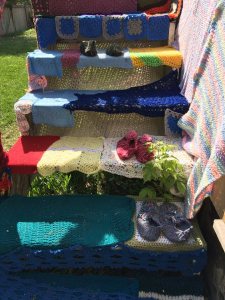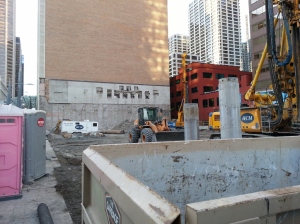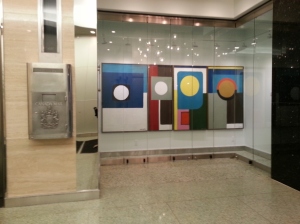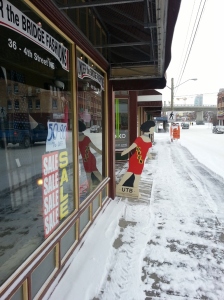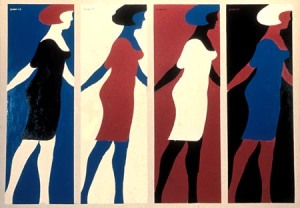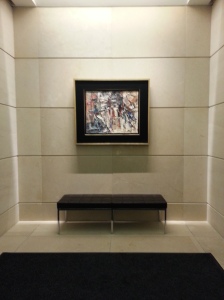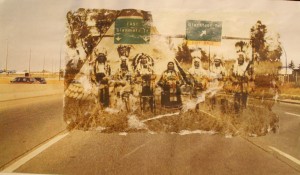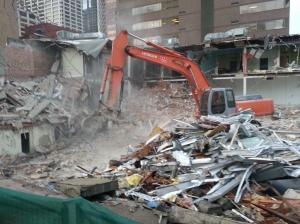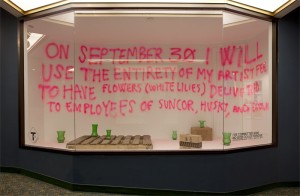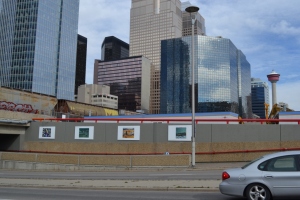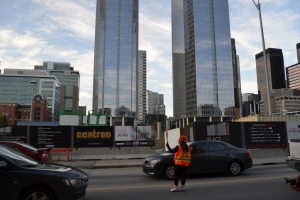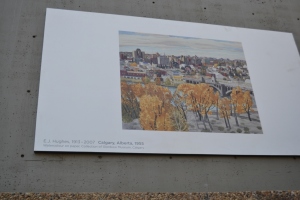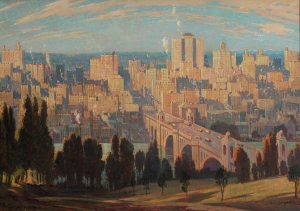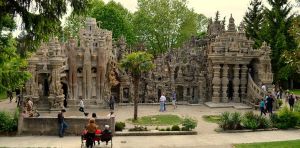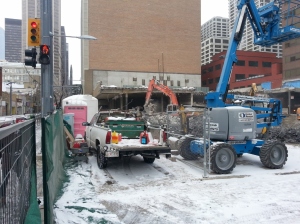
Yesterday afternoon (Sunday) after visiting my family for the holidays, I happened to be downtown and noticed that active demolition work was being performed on the site adjoining the former Art Central Building – which will soon be known as the new Telus Sky Building site.
It is possible that I did not mention it, but I certainly alluded to it previously, that the external walls of the Art Central Building proper (a.k.a. the old Jubilee Block) were fully demolished a little over a week ago. It took longer than what I originally anticipated it would take. I have also noticed demolition is more active on the weekends than it is during the week. I wish that I could say that the same thing happened when the York Hotel was being demolished when I had an active small business operating across the street from it. That is in the distant past and water under the bridge, now that my business has closed. But I digress.
Now the demolition has begun to move on from the Art Central Building (which is complete) and onward to the adjoining Col. James Walker Park and single level building below.
The Col. James Walker Park was little more than a flat cement surface on the +15 level that housed a small open-air fenced off playground made accessible for children who have care facilities in the neighbouring buildings connected to the +15 network.
One of those nearby buildings that contains children during the workweek is the adjoining Len Werry Building. It will be incorporated into the larger Telus Sky building project. In addition to the offices located above in that building, the Len Werry Building also houses the Calgary Board of Education’s W. H. Cushing Workplace School for grades K-3.
From a press release issued earlier this month, the Calgary Board of Education is now seeking a new partnership for this school. The W. H. Cushing School began operations at this location in 1995 and its current lease ends in July 2016. As a casual observer of these type of things, I would now consider it a safe assumption that if the right opportunity came along, all parties involved probably would seriously contemplate ending the lease prematurely. This is especially true given the amount of construction taking place in the immediate area both now and in the immediate future. As many will know, and I know personally from past experience, this type of activity can be highly disruptive to either a business or learning experience.
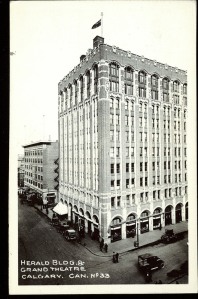
The Len Werry Building has an interesting history. Part of that interesting history is surrounded in confusion. As seen in the photo above the Calgary Herald Building (built circa 1913) has a similar footprint, design and scale to the Len Werry Building. This is especially true, when one considers how the other building later occupied by the Calgary Herald was changed around the same time (see photo below).
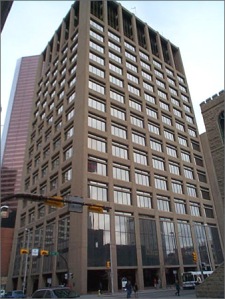
In the interim between the two buildings. The Calgary Herald Building was re-purposed and re-used as the Greyhound Bus Terminal which was its use between circa 1947-1971.
We know that there was some modification at the time its use was changed to allow buses to access the interior of the building. I have seen photos of the building when it was used as a Greyhound Bus Terminal and it appears somewhat similar (at least from the exterior facing 7th Avenue and 1st Street SW) to its previous use as the Calgary Herald Building as seen above. As a result, I question how much modification was done to the exterior except where buses entered and/or left. I would expect that there probably were significant modifications to the interior to allow access for buses as well.
One thing that is interesting about the repurposing of this building is that it housed Luke Lindoe’s first major public art commission (1947). We know that it was a portal relief in concrete. According to information that I have in my possession, and dates from when Luke Lindoe was still living, it is understood that this commission was destroyed. Presumably it was destroyed in the building’s demolition, prior to the Len Werry Building being built circa 1973 or 1974.
In an October 1971 news story in the Calgary Herald, it was indicated that the new Len Werry Building would be 10-storeys high and cost $12-million to build. Obviously there was some changes after that time as it would appear that the current building is slightly higher as seen in the photo above.
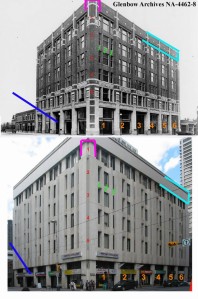
Getting back to the confusion, it increases due to the fact the Calgary Herald later occupied two buildings across the street (the former Southam Chambers Building that was re-clad with marble in the 1970s along with a smaller press building across the alley to the north, as seen in the photo above) both of which were destroyed in either 2012 or 2013. The Southam Chambers Building was built at the same time as the Calgary Herald Building, using the same architect and with the same corporate ownership. Of course anyone that knows much about the newspaper industry would know that the Southam family through their ownership of Southam Newspapers owned the Calgary Herald for a very long time including around 1912 or 1913 when the two buildings were constructed.
The last building that the Calgary Herald occupied downtown resided on the site of the new double-tower Brookfield Place which is now a big hole in the ground. For further reference, Christine Hayes from the Calgary Public Library back in January 2012 wrote this helpful blog post which contains a timeline and photos showing a history of the Calgary Herald and their buildings.
* * *
I guess I have gone on a bit of rambling preamble to the main point of my current post – the terra cotta gargoyles created by English stone carver connected to the Royal Doulton China company, Mark V. Marshall [1879-1912]. Marshall was commissioned by the Southam family to produce these gargoyles I want to talk about further.
To do this properly, we must go back to the period around 1912.
In what was still essentially a frontier town, the population in the City of Calgary had only reached 47,000 at the population height during 1912. It was a time when the city was undergoing rapid growth as evidenced by the formation of the 100,000 Club which anticipated that the population would reach that number by 1915. It was also the year that the Calgary Stampede was recreated in its modern form throwing off the shackles of its Agricultural Fair past dating back to 1886. It was also a time when the focus started in creating a ‘world-class city’ a discussion which continues to the present day.
In that context, there were a couple ideas percolating in the city. One of these was the establishment of public art (a topic that I have written about previously, I probably will write about again, and what I want to talk about now).
I previously have discussed the reproduction of Auguste Kiss’ sculpture Mounted Amazon Attacked by a Panther that was installed in Central Memorial Park (which is still presumed missing); along with Louis Philippe Hébert’s heroic-scaled equestrian commissioned sculpture of an anonymous cavalry officer to commemorate the Boer War which was intended to be paid for by a group led by Major Stanley Jones, but in the end was largely paid for by the City due to unfortunate timing of WWI and drought in the area. Both of these sculptures can make reasonable claims for being the first piece of publicly-situated sculptures in the City.
In the Wikipedia entry that talks about the Hébert sculpture, makes this fabulous claim, “the statue is one and a half times life size, and has been described as one of the four finest equestrian statues in the world.” Although that last part sounds rather intriguing to ponder, interestingly there is no note attributing the source attached. It is a high standard that is claimed, so I would be rather curious to know how the ranking was determined; and what methodology was used to do so. There are some other comments in the same entry that also made me raise an eyebrow as well. To my mind, all these claims as a whole, suggest to me that whomever wrote this part of the entry must be prone to engaging in a bit of world-class thinking, but I digress. All that from trying to remember what the artist’s first name was.
The third public art project in the 1911-1914 period was the gargoyles which I mentioned briefly above.
In the photo at the top of this post which shows the active demolition of the Col. James Walker Park and the one-storey building below shows a series of visible gargoyles.
In the summer of 2013, knowing the ultimate destiny of this park given the news release announcing the Telus Sky development plans, I took photos of the Col. James Walker Park while it was still accessible to the public. Here is a photo of the gargoyles which are attached to the Len Werry Building at that time. In the photo at the top of this post, they still appear to be there.
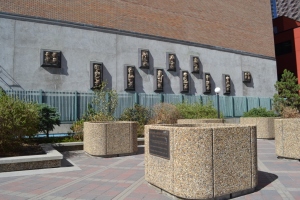
These gargoyles are interesting in themselves, but also are a source of some speculation as well.
The gargoyles were originally attached to both the Calgary Herald Building and the Southam Chambers Building. There was a large number of them which decorated the building exteriors. When the Calgary Herald/Greyhound Bus Lines Building was demolished in 1972 (probably) many of them were salvaged. There was speculation that when the Southam Chambers Building exterior was re-clad in Vermont white marble that the gargoyles attached to that building may have been covered over. Like some speculations this has continued to this day. However in a Calgary Herald article written by the then publisher, Frank Swanson on June 04, 1966 in response to inquiries about what is going on at the Herald building, stated the following:
Several people have expressed dismay that the ancient facing had to be eliminated along with the little gargoyles which decorate the front and side of the building. The fact of the matter was that the old facing of brick and terra cotta had become so weather-beaten and had degenerated so badly that it had become a very considerable hazard. Several pieces, up to the size of a football, have actually dropped off the building in the last two or three years, endangering passers-by below.
So it would seem likely to assume that all the gargoyles were removed from both buildings in the 1966-1972 time period. Whether they were all saved is another question altogether.
Regardless of the ultimate destiny of all the gargoyles, we do know that some gargoyles have been saved.
The January 11, 1973 issue of the Calgary Herald published a photo of two of the gargoyles (see Glenbow Archives photo NA-2864-22325 below).
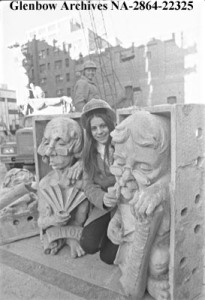
The caption to this photo states:
Carole Garroni, a Calgary Herald newspaper employee, pictured with gargoyles that were removed from the old downtown Greyhound building before it was demolished. The building had once been the home of the Herald newspaper and the gargoyles were caricatures depicting the employees. They were made in England by Royal Doulton. The removal of the Greyhound building made way for the development of a new Alberta Government Telephones building.
One of the two photographed gargoyles, the theatre critic is currently adhered to the wall of the Len Werry Building as seen below. The editor which is the other featured figure in this photo may potentially still be located in the lobby of the Len Werry Building. However, there is still a similar figure, the stenographer which is affixed to the wall like the theatre critic.
We know that there are approximately ten gargoyles (including some ornamental embellishments, which I am going to assume came from one of the two buildings) that have been incorporated into the sandstone exterior of the Alberta Hotel Building at the corner of 8th Avenue and 1st Street SW. These were added at some point after 1973.
When the building was demolished there was a large public outcry about their destiny. Regardless of the outcry, only 240 of the gargoyles were saved. The City of Calgary owns 46 of them. The Glenbow owns a few of the larger gargoyles as well.
In addition there are a few which are located in the Science B Building at the University of Calgary as well and in the Convention Centre. I am sure that there are probably a few others that I am not aware of.
In talking to Frank Hall in the past, I understand that some of them were dispersed through his auction house in the 1970s. They were sold by the City with the proceeds to fund the Historical Preservation Fund for heritage projects. Periodically they still appear. Recently one appeared on eBay and was the subject of a 2007 news story.
And as seen in the photo I took in the summer of 2013 something like 23 are located on the wall of the Len Werry Building at the Col. James Walker Park.
For now the 23 gargoyles are still safe – barely. Although it would appear as if their destiny may very well be the landfill in the very near future, unless some backhoe operator takes compassion upon them. Personally, having witnessed this sort of thing before, I have very little faith in this happening.
The other alternative to their rescue is if someone rallies the cause and draws attention to their potential demise – just like the careers of those who are portrayed on that wall – the theatre critic, the stenographer, the typesetter, B.S.S. the Devil, the Other Architect, and the cleaner that is a union member.
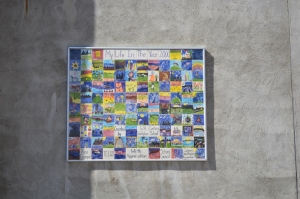
Then there is this mural from the students from the W.H. Cushing Workplace School which is still located in the Col. James Walker Park as well. The students who created this would be in high school now, maybe in university. They have probably forgotten about this project that probably mentions Y2K, as have their parents.

